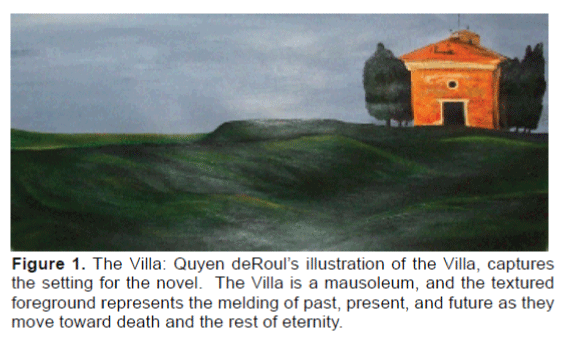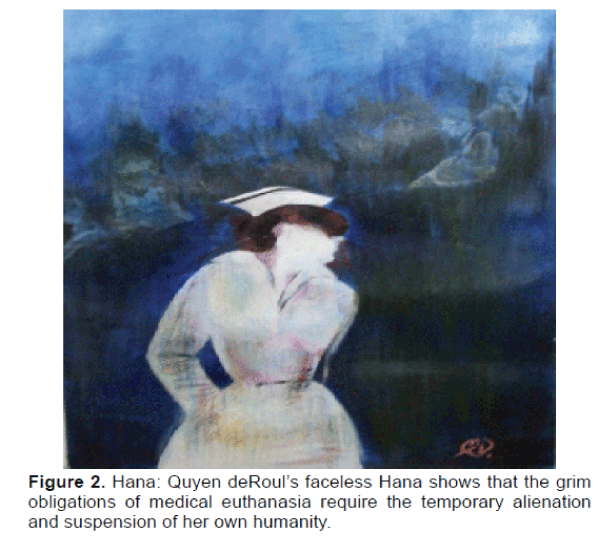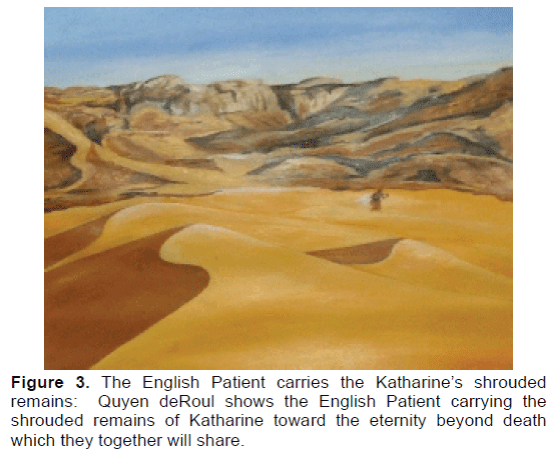Mini Review Open Access
Necrophilia and Medical Euthanasia in Michael Ondaatjes The English Patient: An Illustrated Literary Analysis
James Metcalf*
Professor, George Mason University (MS: 5-B7), Fairfax Virginia
Visit for more related articles at International Journal of Emergency Mental Health and Human Resilience
Abstract
Critical literary analysis of Michael Ondaatje’s The English Patient identifies death as a major part of both its theme and its setting. The English patient himself represents the interface between life and death. His fingers are burned and fused. His face is scarred and expressionless, and the remainder of his frame is wrapped in gauze like a mummy: he is death. Death also surrounds Hana, his nurse. Her baby and its father are dead, as is her own father and of course many of her patients. In a larger sense the villa itself is death, the remains of a time and culture now dead from war. Hana is a nurse among the dead and near dead. Euthanasia is routine…merciful enough, but premeditated murder nonetheless. Ondaatje presents such euthanasia as an ethical part of nursing practice. In Ondaatje’s novel, the past, the present, and the future intersect and entwine as they move toward death and beyond. Life and death are segments upon the same continuum. Necrophilia occurs upon that continuum as a post-mortem episode of a continuing passion.
Death As A Setting
The English Patient is set in Italy during the 1940s. Germans have retreated from dessert campaigns northward across Italy. They destroy what they can and booby-trap the rest. A young Canadian nurse, Hana, deserts her military convoy, refuses to travel farther, and with her dying English patient takes residence in the bombed-out relic of a former nunnery. The structure had served many purposes, but is now dead rubble.
“Sections of the chapel were blown up. Parts of the top storey of the villa crumbled under explosions…Some rooms faced onto the valley with no walls at all. She would open a door and see just a sodden bed huddled against a corner, covered with leaves. Doors opened into landscape. Some rooms had become an open aviary” (Ondaatje, 1993, p. 12-13).
Quyen DeRoule’s illustration of the Villa, see Figure 1, captures the setting for the novel. The villa is a mausoleum. Texture in the foreground represents the intertwining of death and life.
Even the countryside is death. “It is terrible out there. Dead cattle. Horses shot dead, half eaten. People hanging upside down from bridges. The last vices of war… The smell of the dead is the worst. We need a good snowfall to clean up this country. We need ravens” (Ondaatje, 1993, p. 29).
Hana is, herself, plagued by death; her own father, her baby, and the baby’s father are all dead. “I was almost going to have a baby a year ago”…”I lost the child. I mean, I had to lose it. The father was already dead” (Ondaatje, 1993, p. 82).
So many of her young soldiers die that she dehumanizes them. They become indistinct and nameless. “She called everyone ‘Buddy’ ” (Ondaatje, 1993; p 50).
The English Patient As The Life/Death Interface
Hana’s last living patient, the English patient, represents the interface of life and death and also the continuum they share. He had been burned beyond recovery or rehabilitation, salved with ointments, and wrapped with bandages by the Bedouins who saw him crash into the desert. He was a breathing mummy: enshrouded, anointed, and awaiting burial -- a breathing dead man in a dead nunnery.
“They found my body and made me a boat of sticks and dragged me across the desert…They strapped me onto a cradle…” (Ondaatje, 1993, p. 5) “They poured oil onto large pieces of soft cloth and placed them on him. He was anointed.” (Ondaatje, 1993, p. 6)
Medical Euthanasia
Euthanasia derives from two Greek words, eu meaning well or good and thanatos meaning death (Saunders Company, 1965, p. 518 and p. 520). It is often described as mercy killing. In clinical settings, medical euthanasia is used to end the suffering of terminally and hopelessly ill patients. It is certainly homicide, but not always suicide.
Michael Ondaatje portrays medical euthanasia as a routine part of Hana’s nursing practice. The reader might wonder: just what is it to administer lethal doses of morphine to a patient who is in terrible pain and has a life-expectancy of mere seconds?
Hana explains medical mercy to Caravaggio: “I know death now David. I know all the smells. I know how to divert them from agony. When to give the quick jolt of morphine in a major vein. The saline solution. To make them empty their bowels before they die” (Ondaatje, 1993, p. 83-84).
Ondaatje’s euthanasia is compassionate, even benevolent but it is not assisted suicide because the patient is not capable of suicide; nor is it manslaughter. It is murder, and inducing that one last bowel movement before the lethal morphine – to avoid perhaps the greater untidiness of a post-mortem evacuation – shows clear premeditation. It is murder in the first degree, no question.
Hana resents that such tasks fall to her. “Who the hell were we to be given this responsibility, expected to be wise as old priests, to know how to lead people towards something no one wanted and somehow make them feel comfortable” (Ondaatje, 1993; p. 84). Such euthanasia is presented as essential and ethical in nursing practice, but it is a task that takes a heavy toll.
Hana has little choice in the grim obligations that befall her. She must discharge her obligations no matter the cost. DeRoule’s faceless figure (Figure 2) shows Hana’s grim circumstance. She must discharge her obligations even while her own humanity deserts her
Necrophilia
Necrophilia is also derived from two Greek words, necro or dead and philein or to love. It is the abnormal attraction to the dead, including perhaps sexual intercourse with a corpse (W. B. Saunders Company, 1965, p. 984).
Ondaatje uses necrophilia to again demonstrate that life and death are not discrete, but indeed continuous. The English patient returns to the cave of swimmers where he had left the injured Katherine -- just as he had promised -- but much too late. Katherine has been long dead. Here, he ravages her remains. “She had dragged herself into a corner, had wrapped herself tight in the parachute material… She was on her back, positioned the way the mediaeval dead lie” (Ondaatje, 1993, p. 170). “I approached her naked as I would have done in our South Cairo room, wanting to undress her, still wanting to love her” (Ondaatje, 1993, p. 170).
Ondaatje implies that to ravage a dead lover is no desecration, but simply one last carnal episode, an incomplete episode to be sure, as the lover was in transition. The English patient asks “What is terrible in what I did?”…”You can make love to a woman with a broken arm, or a woman with fever” (Ondaatje, 1993, p. 170).
The English patient carries Katherine’s remains toward the horizon (Figure 3). One might interpret the horizon as death. The English patient is still in the transition between life and death, but travels now with Katherine’s remains toward the eternity they will share.
Thoughts For Clinicians
Clinicians, and those who train them, often discuss euthanasia and necrophilia, but typically in a most cursory and superficial manner. Assisted suicide seems a more acceptable term than medical euthanasia; but when the suffering patient is clearly and pathetically incapable of suicide, such euthanasia is murder. Ondaatje suggests that pre-contemplated murder is not only an acceptable part of nursing and medical practice, but also – under certain circumstances -- an unstinting expression of human mercy. Ondaatje offers his readers an opportunity to reflect upon medical euthanasia and to differentiate between assisted suicide and murder in clinical practice.
Necrophilia carries a negative connotation and is commonly presented as a desecration, but Ondaatje challenges that view. If life and death are continuous, then sexual consent must also be continuous. How then is necrophilia a desecration between lovers?
Ondaatje also addresses the character of nursing itself. For a discussion of that, refer to (Metcalf, 2009).
Summary
Death is the setting for The English Patient. The villa, now rubble, is the lifeless remains of a former time. The last medieval war has ended (Ondaatje, 1993, p. 69). Hana lives amidst death. Her childhood and her innocence are both dead, as are her soldiers, her lover, her father, and her baby. One last patient, a breathing mummy, remains in her care. Within this setting, Ondaatje merges past and present into the future: death and whatever is beyond. Past, present, future, and the other side of death occur upon the same continuum.
Ondaatje exposes euthanasia (mercy killing) as first-degree murder in many cases and necrophilia as neither desecration nor sacrilege. His views expand any discussion of necrophilia or medical euthanasia, but only for those willing to challenge the orthodoxy of contemporary views.
Illustrated by
Artist Quyen deRoul, a former student of Dr. Metcalf, submitted original paintings (acrylic) in reaction to the English Patient as a part of a GMU class.
References
- Ondaatje, M. (1993).The English Patient. New York: Vintage International.
- W. B. Saunders Company. (1965). Dorland’s Illustrated Medical Dictionary (24th edition).Philadelphia and London.
- Metcalf, J. (2009). The English patient: Michael Ondaatje’s characterization of the nurse-patient relationship. Creative Nursing, 15(1), 28-30.
Relevant Topics
Recommended Journals
Article Tools
Article Usage
- Total views: 27972
- [From(publication date):
March-2015 - Mar 28, 2025] - Breakdown by view type
- HTML page views : 23280
- PDF downloads : 4692



